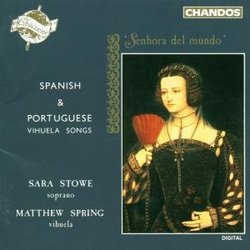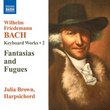| All Artists: Sara Stowe, Matthew Spring Title: Spanish and Portugese Vihuela Songs Members Wishing: 0 Total Copies: 0 Label: Chandos Release Date: 7/26/1994 Genres: Special Interest, Pop, Classical Styles: Vocal Pop, Opera & Classical Vocal, Chamber Music Number of Discs: 1 SwapaCD Credits: 1 UPC: 095115054628 |
Search - Sara Stowe, Matthew Spring :: Spanish and Portugese Vihuela Songs
 | Sara Stowe, Matthew Spring Spanish and Portugese Vihuela Songs Genres: Special Interest, Pop, Classical
|
Larger Image |
CD DetailsSimilar CDs |
CD ReviewsAbout this CD (Informational) Slobberer | Astoria, NY United States | 06/21/2009 (5 out of 5 stars) "Spanish and Portuguese Vihuela Songs
Sara Stowe (voice), Matthew Spring (vihuela) (notes to this CD) In Valladolid in 1469, the Valencian Pope Alexander VI officiated at the wedding of Ferdinand II of Catalonia-Aragón and Isabel I of Castille and León. This event was the beginning of the unification of the two kingdoms, and they were formally joined on the death of John II ten years later. Though the union was little more than formal at first, it was to prepare the ground for the tremendous events that took place following the Wars of Succession: the conquest of the Kingdom of Granada, the advent of the Inquisition, the expulsion of the Jews and of the Moors, and Columbus's voyage to the New World. All these events brought the two kingdoms closer together, and the rich resources of the Spain of the Reyes Católicos (Catholic Monarchs: a title conceded to Ferdinand and Isabel in 1496 by the Pope) was what facilitated that period of prosperity in all artistic fields which has often been referred to as the `Siglo de Oro', the `Golden Age'. It should be noted that the fortunes - both political and cultural - of Portugal were closely interwoven with those of Spain during the whole of this period, and in particular after 1578, the date of the battle of Alcácer-Quibir at which the Portuguese army was almost completely destroyed by the Moors and King Sebastian killed. This fact contributed directly to the political instability which enabled Spain to dominate Portugal for so long. The secular and courtly music produced during this period is quite equal in stature to the sacred polyphony; indeed, it would be strange were it not so, since many composers (Anchieta, Guerrero, and Vázquez, to name but three) worked in both fields. The great sources for the secular songs of the early sixteenth century are manuscript songbooks (cancioneros in Castilian, cancioneiros in Portuguese); the most famous three Spanish collections being the Cancionero de la Columbina, the Cancionero de Palacio, and the Cancionero de Medinaceli to which must be added the Portuguese Cancioneiro musical e poético da biblioteca públia Horténsia (Elvas). This corpus of music was substantially increased by songbooks throughout the sixteenth century, and by printed collections of vihuela music. Instrumental composers were supported by royal and noble patrons to a far greater extent than Spanish song composers (though Vázquez' Recopilación de sonetos y villancicos printed at Seville in 1560 is a notable exception to this rule), so the songs that found their way into print tend to come from collections published by vihuelistas who intabulated vocal music by foreign composers as well as works by their fellow countrymen and of their own authorship. For this recording songs and instrumental solos have been taken from a number of publications of this kind: Luis Milán's Libro de música de vihuela de mano intitulado El Maestro of 1535, Luis de Narváez's Los seys libros del Delphin of 1538, Alonso Mudarra's Tres libros de música en cifras para vihuela (1546), Diego Pisador's Libro de música de vihuela (1552), Esteban Daza's Libro de música en cifras para vihuela intitulado El Parnasso (1576), and the theorist Juan Bermudo's Declaración de instrumentos musicales of 1555. In stylistic terms, the manuscript cancioneros produced a corpus of songs with certain Iberian characteristics. At first sight it may appear that musically this repertoire is somewhat simplistic in comparison with Franco-Flemish secular music of the generation after Josquin. In a sense this is true, but it was this very economy of means that enabled Spanish and Portuguese composers (like their French and Italian contemporaries) to write music which is often deeply moving in a way quite different from the earlier Franco-Flemish composers, whose interest in more complex musical textures could sometimes be at variance with the immediate impact of a good deal of the poetry they set. The usual musical style of the Iberian repertoire, at least until the middle of the sixteenth-century, was to follow broadly the structure of the poem, in three parts, more or less homorhythmically but with more elaboration at cadential points. The chief poetic forms - whose subjects are in popular, courtly or pastoral love, or of a religious nature - to be found in the cancioneros are the villancico (or vilancete) and the canción (or cantiga), both of whose origins appear to stem from the fourteenth century, and which bear resemblances to the Italian ballata and the French virelai (the romance, the third important genre, was concerned with events with a historical basis, which suited perfectly its solemn, repetitive style). At the time of the troubadours in Andalusia there existed an Arabic form called the zéjel, of similar construction to the villancico in that it had solo verses alternating with a choral refrain; but scholars are far from unanimously convinced that there is a direct connection between the two forms. In the villancico the structure usually comprises an initial refrain (estribillo) followed by one or more coplas - verses of different melody and text - and a final return (vuelta) to the melody and rhyme of the estribillo. The numbers of verses became standardized in the late fifteenth century, with the villancico having two or three, and the canción usually four. These characteristics may be found in the majority of the songs contained in the Palacio and Elvas books (the latter copied around 1550, the former in several stages between around 1505 and 1520). The musical and structural similarities between Partí ledo por te ver or A la villa voy from the Elvas book and Ponce's ¡Cómo está sola mi vida! or Encina's Más vale trocar from the Palacio collection are clearly audible. Indeed, the connections between the two anthologies are very close, since a number of the works in the Elvas book, all listed anonymously, are also found in the Palacio book with their authors named. This is true, for example, of Encina's ¿Quién te traxo el cavallero? Spanish and Portuguese sources dating from later in the sixteenth century, contain works which are rather more contrapuntally elaborate, and treat the texts in a more directly emotional way which recent commentators, following the cue of historians of the plastic arts, have begun to label `mannerist'. This term has not, however, been properly defined, and is in any case inadequate - in the same way that `Renaissance' and `Medieval' are - to describe the variety to be found in these collections. The moving simplicity of Senhora del mundo contrasted with the nervous emotional energy of Yo sonhaba que me ablava (both from the Cancioneiro da biblioteca nacional de Lisboa) illustrates this perfectly. The songs found in the collections of the vihuelistas continue what had begun with the great cancioneros, and there are many connections between the two repertoires. Guerrero's famous song Prado verde y florido, for example, which appears in the Cancionero de Medinaceli, was collected by Daza in his El Parnasso of 1576 and then reworked with a religious text (Pan divino, gracioso sacramento) by Guerrero himself and published in his Canciones y villanescas espirituales of 1589. Indeed, Narváez's profoundly beautiful Paseábase el rey moro, in the way in which its musical restraint paradoxically permits a tremendous emotional intensity, represents one of the peaks of Spanish song writing of any century. Sara Stowe studied the piano and harpsichord at The Royal College of Music in London, where she won a scholarship and harpsichord prizes. She studied singing in Italy with the aid of a British Council Award. Sara sings regularly on Radio 3 and with artists including Matthew Spring, James Wood, The Academy of Ancient Music, The Taverner Consort, Folies Bergères, The Broadside Band, Gemini and Singcircle. One of Britain's most versatile performers, Sara first studied piano and harpsichord at the Royal College of Music where she won a scholarship, the continuo and the Raymond Russell harpsichord prizes. A British Council award and vocal studies in Italy followed and she met and worked with Luciano Berio. Her ability to characterise her voice in so many different styles has led her to perform and record with a wide range of new and early music groups including: Matthew Spring (broadcasts on BBC Radio 3 , Classic FM and recording on Chandos), The Academy of Ancient Music (Decca), New London Consort (Decca), the Broadside Band, Sinfonye, James Wood (Continuum), Gemini and Singcircle. She has also featured twice on BBC Radio's Woman's Hour. Matthew Spring read music and history at Keele University and at Magdalen College, Oxford, where he completed a D.Phil on the lute. He went on to study the lute at the Royal College of Music and now follows parallel careers as performer and musicologist. Matthew presently lectures at various universities, including London Guildhall University where he held a Leverhulme Research Fellowship. " |

 Track Listings (27) - Disc #1
Track Listings (27) - Disc #1
